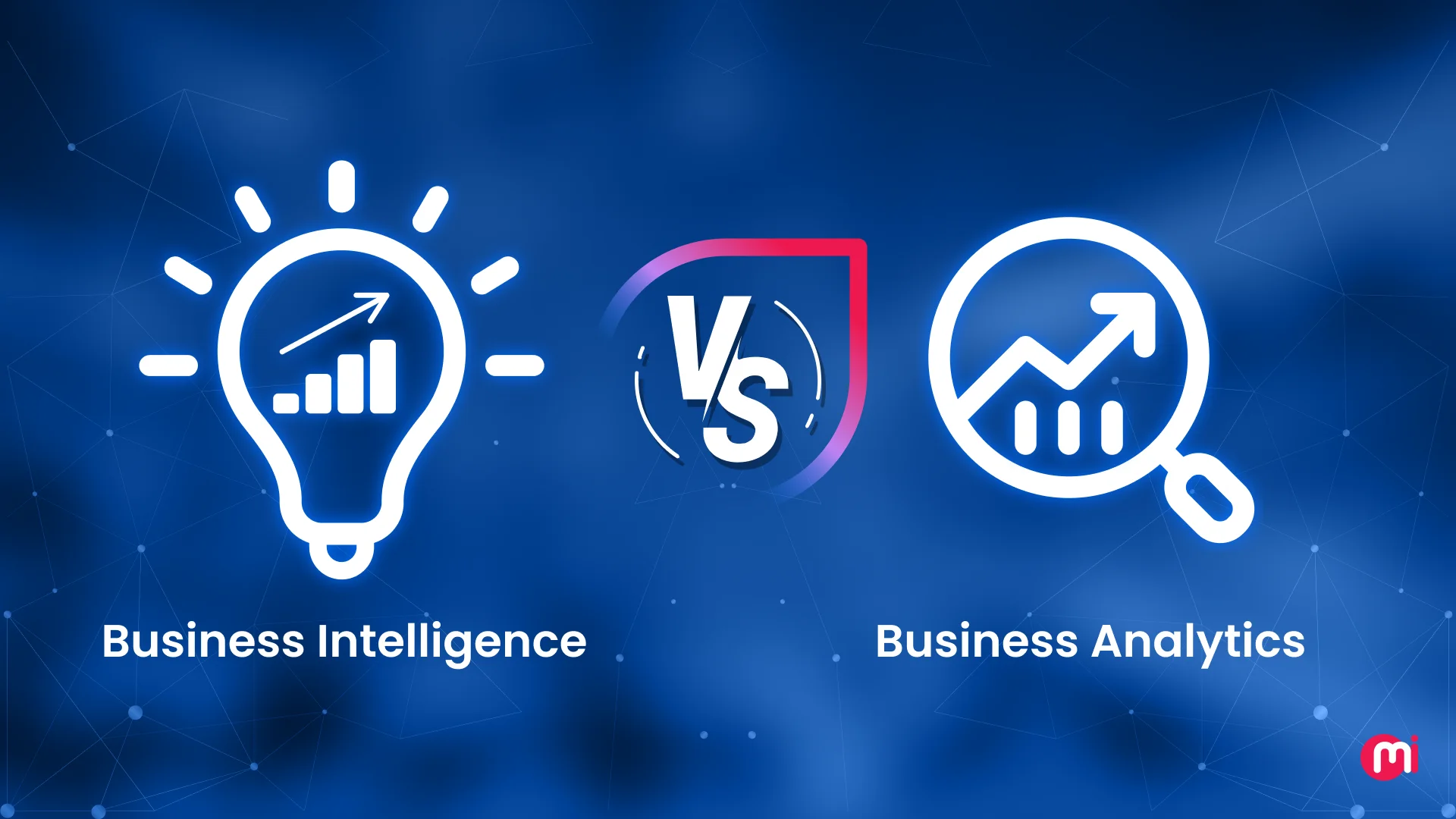Digital Transformation in Banking: Driving Factors, Challenges, Benefits, And More
- Business
- April 15, 2024
Digital transformation in the banking industry is one of the most lucrative ways for financial institutions to stay relevant and competitive in this digital era. In this blog post, explore the key driving factors, challenges, benefits, and practical steps to initiate this transformative journey of digital innovation.
When was the last time you visited the bank? I bet it’s hard to recall, and digital transformation is precisely the reason for it.
Customer-centricity is what financial institutions(FIs) are adopting these days. This shift is not solely attributed to technological advancements but also reflects the evolving dynamics of how individuals interact with their finances.
FIs are increasingly recognizing the importance of earning and maintaining customers’ trust. To achieve this, they are reimagining conventional banking operations and embracing digital transformation(DX).
Financial service providers who are yet to embark on a journey of DX must recognize that we live in an era where neo-banks(digital-only banking platforms) like N26, Starling Bank, Varo, Revolut, and more are the new normal. Particularly among Millennials and Gen Zs, who possess significant financial literacy, there is a growing preference for digital banking services over traditional ones.
Before we get into learning the fundamentals of DX in banking, here are some statistics that underscore the significance of digital innovation in the banking industry as an essential step for banks to not only survive competition but also adapt to the evolving needs of customers:
- Neobanks number of users is expected to reach 386.30m by 2028 according to a market insight by Statista.
- As mentioned by the Statista research department, the number of digital banking users in the United States alone is forecasted to reach almost 217 million by 2025.
- In an industry report by Mordor Intelligence, the digital banking platform market size is estimated at USD 10.14 billion in 2024, and is forecasted to grow at a CAGR of 14.04% during the forecast period (2024-2029) and reach USD 19.56 billion by 2029.
What is Digital Transformation in Banking?
Digital transformation is a multifaceted process that involves adopting digital solutions powered by modern technologies (like artificial intelligence, cloud computing, blockchain, etc) and strategies in conventional banking operations. Apart from being an operational shift, for many traditional methodology drive banks, it is a huge cultural shift.
Adopting technology empowered financial institutions to redefine rather than transform finance and accounting processes. Not only that, it has a substantial impact on the way consumers interact with their finances and banking services.
Factors Driving Digital Transformation in Banking and Financial Services
Keeping up with the trends is not the only reason, C-level executives in the banking sector opt for DX. Here are some of the underlying factors that drive the requirement for digital transformation in the banking sector.
The emergence of a digitally driven market
Gone are the days when you would spend minutes listening to the IVR just to get in touch with the customer care executive to get your queries resolved.
Now, when one thinks about banks it is no longer long queues, a lot of forms to be filled, and most time spent in the waiting space. It is more like making banking services accessible to consumers to the extent that it has almost eliminated the need to go to a bank anymore. It is not wrong to say that today the banks go to the customers virtually than the other way round, unlike old times. Thanks to the digitally driven world and digital transformation company like ours!
Advancements in technology
We live in a time where we use facial recognition and biometrics casually for authentication. The use of AI-powered chatbots is the new normal for getting answers and suggestions for almost everything. Customers utilize robo-advisors to get investment advice.
Banks not using these widely adopted technologies would make them obsolete.
Also Read: How biometric authentication is empowering bank security?
Complex local and global compliance requirements
As far as a large sum of the amount of money and sensitive consumer data is concerned, compliance with regulatory norms and judicial laws becomes inevitable. Whether it is KYC regulations, anti-money laundering compliance, data privacy and protection regulations, tax regulations, cybersecurity regulations, and more.
Automated systems and digital tools (like a RegTech platform, KYC automation platform, etc) make it easier for banks to mitigate compliance risks and adhere to regulatory standards.
Power of data
Even in the “pre-digital” era when everything was managed manually, banks always had access to huge amounts of data. However due to human limitations in processing that data and making insightful data sets out of it seemed a significant challenge.
Big data technologies(data mining, storage analytics, and visualization) have made it possible for FIs to derive valuable insights from the vast amounts of data they possess to use this insight to enhance operation efficiency and deliver superior customer experiences.
Challenges of Digital Transformation in Banking
Though banking and digital transformation seem like a need of the hour for this sector, it is not necessarily easy, as it can be both challenging and complex. Here are several aspects that would contribute to the difficulty of the process:
Interoperability with banking systems
Legacy core banking systems and IT infrastructure developed a decade ago or even earlier might have outdated protocols, data formats, conventional technology, and more.
Integrating mobile banking apps or net banking websites with legacy systems can be challenging due to the differences. Banks often need to invest significant time and resources in developing middleware or integration layers to bridge the gap between their legacy systems and modern digital solutions.
Legacy systems and technical debt
Just integrating these legacy systems is merely a small challenge then modernizing them. Apart from being incompatible with modern technologies, these systems and their IT infrastructures are outdated, inflexible, have limited scalability, and are siloed. These systems are also incapable of providing a seamless omnichannel experience to the customer.
Along with data migration from these systems to new platforms, the smooth adoption of new technologies for the employees using the legacy systems for years also poses a substantial challenge.
Data management and analytics
Though it has been one of the driving factors for the need for digital transformation in the banking sector, the issue of data quality and integration arises. In many banks, data is often stored in siloed systems across different departments or business units. This fragmentation makes it challenging to access, integrate, and analyze data comprehensively.
Further, increasing digitization exposes banks to cybersecurity threats, with the potential for data breaches and unauthorized access to sensitive customer information. This then leads to staying compliant with strict regulatory requirements.
Security and compliance
Let’s talk about security first. Having a software solution developed by a company providing exceptional finance software development services in place may not be enough as these digital systems can be vulnerable to cyberattacks. Cybercriminals are always on the hunt for the smallest of loopholes to reach the system and steal user’s data.
The Equifax data breach is one of the best examples of how things can go south when cybercriminals find a minute vulnerability as simple as a delay in updating a security patch to a renowned software. This data breach affected 143 million people which at the time was more than 40% US population.
Must Read: How to develop a secure mobile banking app?
Further, stringent regulatory requirements govern the financial industry, which vary across regions and evolve. Due to this, global banks face the complexity of complying with different regulations across multiple jurisdictions. There are also regulatory requirements when adopting new technologies and processes. Failure to comply leads not just to a breach of trust and credibility with customers but also to hefty fines and penalties.

Benefits of Digital Transformation in Banking
Whether it is investment banking, commercial banking, retail banking, or any such type of financial service, the benefits of digital transformation in banking are for them all. Here are some of the reasons why DX is needed in banking and financial services:
Enhanced customer journeys
For banks, being able to offer a seamless omni-channel experience to their customers throughout their digital journey has become indispensable recently. Digital transformation seems to meet this by offering integrated solutions that unify the customer experience across various channels, including online banking, mobile apps, ATMs, and physical branches. This accessibility is neither place nor time-bound when it comes to offering a holistic digital banking solution.
Additionally, through data analytics and artificial intelligence, banks can personalize customer interactions across channels. By analyzing customer behavior and preferences, banks can offer targeted product recommendations, personalized offers, and proactive support, enhancing the overall customer experience.
Better customer acquisition
The fact that the customer no longer has to visit the branch in person even to open a bank account or the onboarding process, not even for identity verification as it is now done with video KYC. This has added convenience to the conventional cumbersome process, especially for individuals who reside in rural areas and must travel to cities to visit the branch.
The immediate access to banking service is highly appealing for the prospects given its efficiency, expanded reach, and accessibility. This empowers banks to become more inclusive and have a diverse customer base improving customer acquisition.
Drive efficiency and automation
With the implementation of RPA, the software robots automate routine and repetitive tasks such as data entry, reconciliation, and report generation. RPA ensures high accuracy levels by executing tasks with precision, minimizing the risk of errors. With RPA, banks can achieve cost savings by streamlining operations and reducing the need for manual labor. It can also ensure accurate and timely submission of regulatory documents.
To summarize, automation offers several benefits such as operational streamlining, cost reduction, enhanced customer experiences, faster decision-making, improved risk management, regulatory compliance, and more.
Prevent fraud and satisfy compliance
Often, after making a large transaction via credit card or an online payment channel, we receive a call from a bank executive to confirm whether the transaction was performed by us. This simple example illustrates how banks utilize customer transaction analytics to flag any transaction pattern that deviates from the customer’s typical behavior, indicating potential fraudulent activity. This is achieved through an AI and ML-powered bank’s fraud detection system developed by AI developers, enhancing fraud prevention measures.
For compliance, the best and most widely adopted approach by banks is deploying regulatory technology (RegTech) solutions equipped with automation capabilities. These solutions assess the bank’s compliance status and generate reports to demonstrate adherence to regulatory standards.
Better data analytics and insights
Using AI and ML technology in digital transformation facilitates your digital solutions with real-time and predictive analytics. These features of this advanced technology can be used to gain better insights into the available data, which can be leveraged in various aspects of service offerings. Thus, offering executives data-driven decision benefits.
Personalized offerings
One of the major benefits of data analytics and insights, which has a positive impact on ROI, is using this valuable data insight to offer customers personalized offerings.
These offerings may include credit card rewards, location-based discounts, personalized savings goals, and more, which are highly likely to be accepted by users as they perfectly align with their preferences and financial history. Upon doing so, customers experience a higher level of satisfaction as they receive timely and personalized suggestions.

How To Begin A Digital Transformation In Banking?
Upon realizing the importance of digital transformation in banking, the only task remains to figure out a way to implement it in your banking business. Here are the ideal steps for beginning with DX in banking and financial services:
Define your objectives and values
Setting clear objectives and goals provides clarity of purpose, defines the direction of efforts, enables effective resource allocation, and ensures alignment toward goals in the organization, particularly for the digital transformation initiative in FIs.
For a bank, these objectives could include operational efficiency, enhanced customer experience, staying ahead of competitors, cost reduction, and so on.
Set KPIs
Having various matrices in place enables business executives to track progress and success along with identifying areas where improvement is required, iterating on strategies, refining processes, and making data-driven decisions toward achieving desired outcomes efficiently and effectively.
These KPIs can be Customer Acquisition Rate, Online Banking Active Users, Average Time to Resolve Customer Queries, Time-to-Market for New Digital Offerings, Compliance Adherence Score, and more.
Evaluate your culture
Resistance to change is often expected when an organization is going through a technological shift this big. Evaluating your culture empowers the banks to assess the readiness of their workforce for this change. Further, it helps in employee attitudes and behaviors, identifies talent gaps and areas for skill development, and more to understand and address cultural factors early on.
Understand customer needs
With FIs adopting a customer-first approach, banks need to cater digital solutions to their need and preferences. To do so, learn about your customers’ preferences, behaviors, and pain points. further, use this data for analytics to identify areas where digital solutions can enhance their banking experience and address their evolving needs.
Invest in technology and infrastructure
Begin by assessing the current IT infrastructure capabilities to understand the technology and infrastructure gaps that need to be addressed to achieve the desired digital capabilities. This may involve upgrading/migrating core banking systems, implementing digital channels (such as secure mobile banking apps and online platforms), and integrating new technologies like AI and automation.
Doing all of this with the help of an in-house tech team could be a cumbersome and exhaustive task. Instead, consider outsourcing digital transformation services from a company with a team of vetted development experts.
Define a strategy
Once you have the essential information that you would require for implementing digital transformation, it is time to establish a realistic timeline comprising milestones, agile methodologies, and resource allocation, for corresponding KPIs. This comprises breaking down the digital transformation process into manageable phases or projects. Then implementing them based on their impact and feasibility, incrementally to minimize disruptions and maximize benefits.
Engage your team
Foster collaboration and communication across departments to ensure alignment and coordination throughout the process. Also, do not neglect the need for training and development to equip employees with the skills and knowledge needed to embrace digital tools and processes.
Analyze and modify
Upon the beginning of implementation until all the desired goals are achieved, continuously monitor the progress of the digital transformation initiative and measure performance against established KPIs.
Survey feedback from customers and employees to identify areas for improvement and make necessary adjustments to the strategy and implementation approach. Evolve the digital solution based on feedback, market trends, and emerging technologies to maintain relevance and keep driving sustainable growth.
How MindInventory Catalyzes Digital Transformation in Your Banking Operations?
MindInventory – a leading AI & ML development company offers a comprehensive range of services and expertise to support banks in digitally transforming their operations, driving innovation, and staying competitive in the evolving financial landscape. Our development team is well-versed in the latest technologies, including artificial intelligence, machine learning, blockchain, data science, and more.
Our mobile app development expertise enables us to provide your bank with a robust custom mobile application for better accessibility to your banking services. We also focus on user experience (UX) and user interface (UI) design to create intuitive and engaging digital banking interfaces that enhance usability and satisfaction for customers.
Furthermore, we ensure that the digital solution aligns with industry regulations and standards to maintain the security and integrity of financial services. Contact our expert team at MindInventory to begin your banking business’s journey of digital transformation.
FAQs on Digital Transformation in Banking
From making transactions anytime anywhere without the requirement of having cash to making quicker and more secure transactions and sending money to your friends or family, the retail baking industry has evolved at an unprecedented rate recently. Digital solutions in retail banking comprise mobile apps, digital payments, personalized customer service, and more. In a nutshell, digital transformation in retail banking makes purchases more convenient and banking services more accessible. For banks, it makes operations more efficient and enables them to stay ahead of the curve.
Digital banking relies on various technologies to provide seamless and secure banking services to customers. Some of the key technologies used in digital banking include Artificial Intelligence and machine learning, Blockchain/distributed ledger technology, Big Data, Cloud Computing, mobile banking, biometric technologies, cybersecurity, robotics, Internet of Things, Application Programming Interfaces, microservices-based architectures, and Augmented Reality (AR).
There are several types of digital banking, each offering different services to make banking more convenient. Some of them are mobile banking apps, internet baking websites, peer-to-peer payments, personal financing solutions, digital wallets, investment platforms, and more.
Introducing digital transformation in accounting requires a lot of manual work, apart from it having a positive impact on efficiency, security, accuracy, collaboration, cost saving, decision making, and advanced insights.
Some often practical applications of digital transformation in banking are digital onboarding, digital payments, mobile/online banking apps, data analytics solutions, personalized service offerings, personalized customer insights, data encryption software, KYC system software, chatbots and virtual assistants, Robotic Process Automation, and more.













